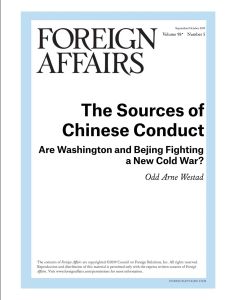Join getAbstract to access the summary!

Join getAbstract to access the summary!
Odd Arne Westad
The Sources of Chinese Conduct
Are Washington and Beijing Fighting a New Cold War?
Foreign Affairs, 2019
What's inside?
The United States must base its China policy on a thorough analysis of Chinese motivations and capabilities.
Recommendation
George F. Kennan’s 1946 Foreign Affairs article, “The Sources of Soviet Conduct,” provided one of the most influential underpinnings for America’s Cold War policy of containment. What made Kennan’s analysis so compelling was that it was based on a deep understanding of Russian history and Soviet ideology. Today’s US policymakers need a similar document to inform US China policy, historian Odd Arne Westad argues. While some of Kennan’s strategic lessons also apply to China, Westad convincingly explains why containment 2.0 needs important updates.
Summary
About the Author
Odd Arne Westad is Professor of History and Global Affairs at Yale University and the author of The Cold War: A World History.


















Comment on this summary